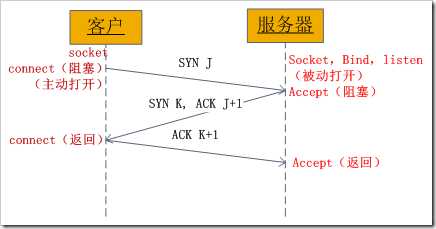一、网络的基础知识
1、OSI参考模型
OSI是Open System Interconnect的缩写,意为开放式系统互联。一般都叫OSI参考模型,是ISO组织在1985年研究的网络互联模型。该体系结构标准定义了网络互连的七层框架,在这一框架下进一步详细规定了每一层的功能,以实现开放系统环境中的互连性、互操作性和应用的可移植性。
OSI七层参考模型的各个层次的划分遵循下列原则:
1、同一层中的各网络节点都有相同的层次结构,具有同样的功能。
2、同一节点内相邻层之间通过接口(可以是逻辑接口)进行通信。
3、七层结构中的每一层使用下一层提供的服务,并且向其上层提供服务。
4、不同节点的同等层按照协议实现对等层之间的通信。

数据链路层
网络层
传输层
会话层
表示层
这一层主要解决拥护信息的语法表示问题。它将欲交换的数据从适合于某一用户的抽象语法,转换为适合于OSI系统内部使用的传送语法。即提供格式化的表示和转换数据服务。数据的压缩和解压缩, 加密和解密等工作都由表示层负责。
应用层
TCP (Transmission Control Protocol)和UDP(User Datagram Protocol)协议属于传输层协议。其中TCP提供IP环境下的数据可靠传输,它提供的服务包括数据流传送、可靠性、有效流控、全双工操作和多路复 用。通过面向连接、端到端和可靠的数据包发送。通俗说,它是事先为所发送的数据开辟出连接好的通道,然后再进行数据发送;而UDP则不为IP提供可靠性、流控或差错恢复功能。一般来说,TCP对应的是可靠性要求高的应用,而UDP对应的则是可靠性要求低、传输经济的应用。TCP支持的应用协议主要 有:Telnet、FTP、SMTP等;UDP支持的应用层协议主要有:NFS(网络文件系统)、SNMP(简单网络管理协议)、DNS(主域名称系 统)、TFTP(通用文件传输协议)等.
TCP/IP协议与低层的数据链路层和物理层无关,这也是TCP/IP的重要特点。
二、Socket
socket本质上就是在2台网络互通的电脑之间,架设一个通道,两台电脑通过这个通道来实现数据的互相传递。 我们知道网络 通信 都 是基于 ip+port 方能定位到目标的具体机器上的具体服务,操作系统有0-65535个端口,每个端口都可以独立对外提供服务,如果 把一个公司比做一台电脑 ,那公司的总机号码就相当于ip地址, 每个员工的分机号就相当于端口, 你想找公司某个人,必须 先打电话到总机,然后再转分机 。
建立一个socket必须至少有2端, 一个服务端,一个客户端, 服务端被动等待并接收请求,客户端主动发起请求, 连接建立之后,双方可以互发数据。

socket中TCP的三次握手建立连接详解
我们知道TCP建立连接要进行“三次握手”,即交换三个分组。大致流程如下:
- 客户端向服务器发送一个SYN J
- 服务器向客户端响应一个SYN K,并对SYN J进行确认ACK J+1
- 客户端再想服务器发一个确认ACK K+1
只有就完了三次握手,但是这个三次握手发生在socket的那几个函数中呢?请看下图:
socket中发送的TCP三次握手
从图中可以看出,当客户端调用connect时,触发了连接请求,向服务器发送了SYN J包,这时connect进入阻塞状态;服务器监听到连接请求,即收到SYN J包,调用accept函数接收请求向客户端发送SYN K ,ACK J+1,这时accept进入阻塞状态;客户端收到服务器的SYN K ,ACK J+1之后,这时connect返回,并对SYN K进行确认;服务器收到ACK K+1时,accept返回,至此三次握手完毕,连接建立。
总结:客户端的connect在三次握手的第二个次返回,而服务器端的accept在三次握手的第三次返回。
A network socket is an endpoint of a connection across a computer network. Today, most communication between computers is based on the Internet Protocol; therefore most network sockets are Internet sockets. More precisely, a socket is a handle (abstract reference) that a local program can pass to the networking application programming interface (API) to use the connection, for example "send this data on this socket". Sockets are internally often simply integers, which identify which connection to use.
For example, to send "Hello, world!" via TCP to port 80 of the host with address 1.2.3.4, one might get a socket, connect it to the remote host, send the string, then close the socket:
|
1
2
3
4
|
Socket socket = getSocket(type = "TCP")connect(socket, address = "1.2.3.4", port = "80")send(socket, "Hello, world!")close(socket) |
A socket API is an application programming interface (API), usually provided by the operating system, that allows application programs to control and use network sockets. Internet socket APIs are usually based on the Berkeley sockets standard. In the Berkeley sockets standard, sockets are a form of file descriptor (a file handle), due to the Unix philosophy that "everything is a file", and the analogies between sockets and files: you can read, write, open, and close both. In practice the differences mean the analogy is strained, and one instead use different interfaces (send and receive) on a socket. In inter-process communication, each end will generally have its own socket, but these may use different APIs: they are abstracted by the network protocol.
A socket address is the combination of an IP address and a port number, much like one end of a telephone connection is the combination of a phone number and a particular extension. Sockets need not have an address (for example for only sending data), but if a program binds a socket to an address, the socket can be used to receive data sent to that address. Based on this address, internet sockets deliver incoming data packets to the appropriate application process or thread.

